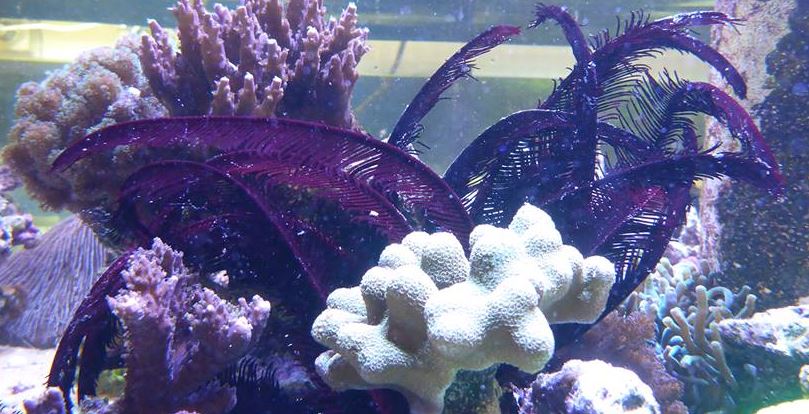Physical Description
Cenolia glebosus is a comatulid crinoid (Feather Star - Figure 2) within the family Comasteridae. Therefore the adult form is a stalk-less crinoid possessing one or two paired like projections on a number of the outer segments of the oral pinnules (side branches closest to the base of the arms) that form structures called combs.

Figure 2 - Cenolia glebosus in UQ Aquarium. Photo taken by Sophie Horsfall
Due to only having 30 known occurrences along the eastern coast of Australia, C. glebosus has only been described as a species once in a paper by Rowe et. al. (1986), but its family, genus and class have all been thoroughly described throughout the literature.
Orientation
As like other crinoid species, C. glebosus is anchored to the substrate using cirri on its aboral side with its mouth and anus facing upwards, on the dorsal or oral side of the animal, with its arms spread out horizontally with the tips flexed inwards towards to mouth (Alender et al 1966).
Colour
C. glebosus is commonly called a black feather star, but is actually dark brown with a slightly darker median longitudinal line, or center line along the length of the dorsal (upwards facing) arm surface. (Rowe et al 1986).
Size
Rowe et al (1986) describes C. glebosus as having arm lengths of approximately 150 mm with pinnules, feather like jointed appendages, of about 20 mm in length. The cirri (curved hook like structures that attach the individual to the substrate) were a maximum of 17 mm long and were attached to the centrodorsal (the central boney plate on the downward/aboral side of the animal) of about 7 mm in diameter (Rowe et al 1986). The surfaces of the calyx cup or disc, the main fleshy body portion of the body containing the mouth and anus, were also found to be covered in numerous calcareous nodules of approximately 2.5 mm in diameter (Rowe et al 1986). The four individuals collected from Stradbroke Island’s Amity Point followed this description with arms of 150-200 mm long, cirri 10-15 mm long, pinnules of 10-20 mm in length, and centrodorsal plate of approximately 5-8 mm attached to a central calyx disc of approximately 10-12 mm in diameter.
Identifying Features
C. glebosus has between 10 and 40 arms with pinnule combs of approximately 5-17 segments and up to 6 transverse bar-like teeth near the attachment to the arm with the remaining comb segments containing a pair of equally sized teeth that extend the whole length of the arms (Rowe et al 1986). The central calyx disc also contains spherical calcareous, calcium carbonate, nodules across its surface, with the number of calcareous nodules varying with size (Rowe et al1986). There are usually 36 cirri containing 13-23 segments and are arranged around the centrodorsal in two or three staggered rows (Rowe et al 1986). It should be noted that the number of cirrus segments varies with size with smaller individuals containing fewer cirrus segments (Rowe et al 1986). The three individuals collected from Stradbroke Island’s Amity point had approximately 10 arms and over 30 cirri in 2 two staggered rows.
C.glebosus differs from other closely related species such as C.benhami, trichoptera, tasmaniae and spanoschistum, in the smaller centrodorsal and cirri, comb form, colour, body form, cirrus ornamentation and geographical distribution (Rowe et al 1986). It's main identifying feature from all other species within the genus Cenolia is the presence of the characteristic nodules on the central disk (Rowe et al 1986).
|